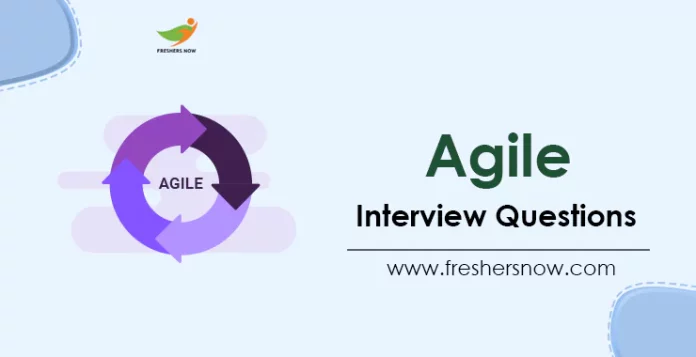
This article offers a set of Top 50 Agile Interview Questions and Answers that can assist in achieving a better understanding of the subject matter.
★★ Latest Technical Interview Questions ★★
Agile Interview Questions and Answers
Irrespective of whether you’re a novice or an adept developer, this compilation of Top 50 Agile Interview Questions and Answers encompasses both fundamental and advanced Agile Technical Interview Questions. Therefore, with these Agile Interview Questions for Freshers, you can effectively prepare for your Latest Agile Interview Questions and increase your chances of acing them. So, let’s delve into the Agile world and gear up for your interview.
Top 50 Agile Interview Questions and Answers
1. What is Agile methodology, and how does it differ from traditional project management?
Agile methodology is an iterative and incremental approach to project management that emphasizes flexibility and adaptability. It differs from traditional project management in that it places a greater emphasis on collaboration, communication, and responding to change.
2. What do you mean by Pair Programming? Write its advantages.
Pair programming is a collaborative programming technique where two individuals work together to write code, sharing one computer or machine. It is commonly employed in Agile software development methodologies. During pair programming, one person writes the code while the other reviews each line and checks for errors. They also switch their roles intermittently to ensure both individuals are engaged and contributing equally.
Advantages of Pair Programming
- Develop higher-quality code
- Reduce the risk of errors
- An effective way to share knowledge
- Enhanced productivity
- Improved team collaboration
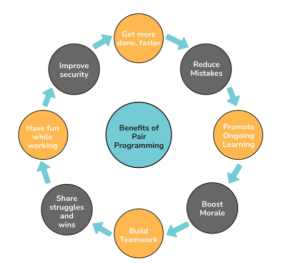
3. How do you handle changing requirements in Agile development?
In Agile development, changing requirements are expected, and the Agile process is designed to accommodate them. This is achieved through constant communication with the customer, continuous testing and feedback, and prioritizing the product backlog based on the customer’s needs.
4. What is the Agile Manifesto, and what principles does it embody?
The Agile Manifesto is a statement of values and principles for Agile software development. It embodies a focus on individuals and interactions, working software, customer collaboration, and responding to change. It emphasizes delivering working software frequently and involving customers and stakeholders in the development process.
5. What are the roles and responsibilities of the Scrum Master in Agile?
The Scrum Master is responsible for facilitating the Scrum process and ensuring that the team follows the Agile principles and practices. They also remove any impediments that may prevent the team from achieving their goals and work closely with the product owner to prioritize the product backlog.
6. What do you mean by the term “velocity” in Agile?
Velocity is a metric used in Agile software development to measure the amount of work a team can complete within a single sprint and estimate the time required to complete a project. It serves as a valuable tool for teams to calibrate their work capacity and create realistic timelines. Furthermore, velocity enables teams to identify potential bottlenecks and measure their progress and improvements over time.
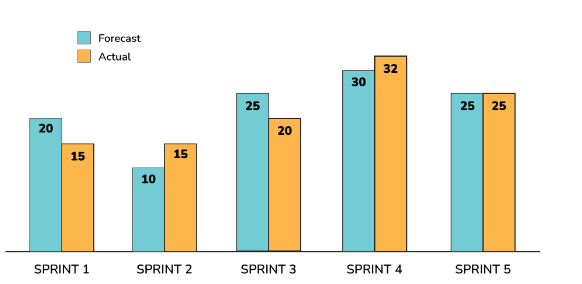
7. What is a sprint, and how is it different from a release?
A sprint is a time-boxed period of development in Agile that typically lasts two to four weeks. It is used to complete a set of user stories or tasks from the product backlog. A release, on the other hand, is a deployment of a completed set of features to the end users.
8. What is the Agile process for estimating and planning projects?
The Agile process for estimating and planning projects involves breaking down the project into smaller user stories or tasks and estimating the effort required to complete each one. The team then prioritizes these items and plans the sprint backlog based on the highest priority items.
9. What is a user story in Agile, and how is it used?
A user story in Agile is a short description of a feature or functionality from the perspective of the end-user. It is used to define requirements and prioritize development efforts based on the value they deliver to the customer.
10. What are the main artifacts of the Scrum Framework?
There are three main artifacts of the Scrum Framework:
- Product Backlog: A product backlog is an organized list of all the work that needs to be done on the product. It includes requirements from clients or stakeholders that should be accomplished before the end of the project.
- Sprint Backlog: A sprint backlog is a list of all the work items selected by the scrum team for completion during the current sprint. It includes finalized user stories, bug fixes, and other work items that the team commits to completing during the sprint.
- Product Increment: A product increment is the updated version of the product that is derived from the completion of each sprint. It is the sum of all the completed and implemented user stories, features, and functionalities that have been developed and tested during the sprints.
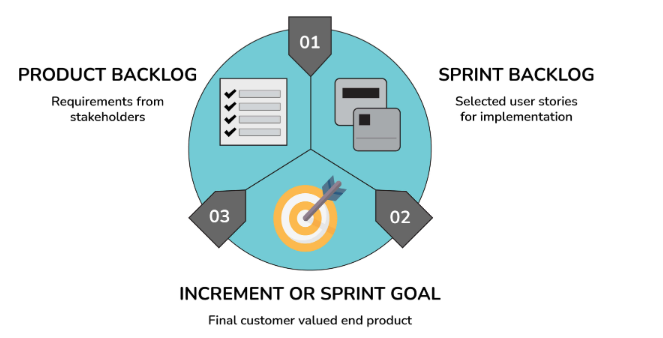
11. How do you prioritize the product backlog in Agile development?
In Agile development, the product backlog is prioritized based on the value it delivers to the customer. This is achieved by working closely with the product owner and stakeholders to understand their needs and priorities and then ordering the backlog items accordingly.
12. What is the difference between a product backlog and a sprint backlog?
A product backlog is a prioritized list of features and functionalities that need to be developed over the course of the project, while a sprint backlog is a list of items from the product backlog that are selected for development during a sprint.
13. What is pair programming in Agile, and how is it beneficial?
Pair programming in Agile:
- A practice where two programmers work together on a single task or user story
- One person is the “driver” and writes the code while the other is the “navigator” and reviews the code as it is being written
- Benefits include increased code quality, knowledge sharing, reduced errors, and improved team collaboration and communication
14. What do you mean by refactoring?
Refactoring is the process of modifying the internal structure of software without altering its external behavior or functionality. It involves making changes to the code to enhance its internal structure, making it more readable, maintainable, and efficient. One popular refactoring technique used in Agile software development is Red-Green refactoring. Consistent refactoring habits improve code maintainability and ease of extension, ultimately resulting in a more robust and reliable software system
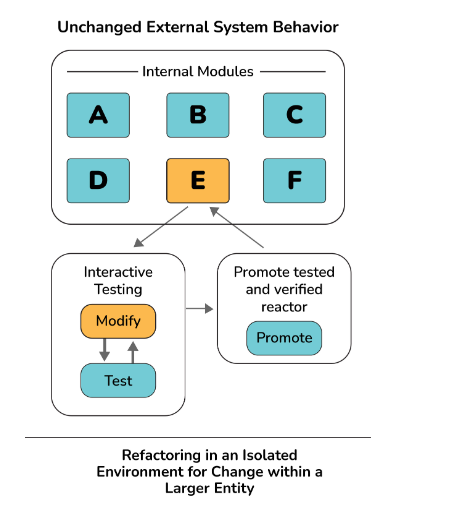
15. What are the key differences between Agile and Waterfall methodologies?
| Agile | Waterfall |
|---|---|
| Iterative and incremental | Sequential |
| Emphasizes flexibility and adaptability | Emphasizes planning and predictability |
| Prioritizes working software and customer collaboration | Prioritizes documentation and contract negotiation |
| Encourages continuous feedback and improvement | Follows a linear, one-way path |
| Values individuals and interactions over processes and tools | Values processes and tools over individuals and interactions |
16. How do you implement continuous integration in Agile development?
Continuous integration in Agile:
- A practice of merging and testing code changes frequently and automatically
- Integration is done at least daily, ideally multiple times a day
- Benefits include reduced integration issues and faster feedback on code changes
17. What is the difference between an Agile coach and an Agile consultant?
Agile coach vs. Agile consultant:
- An agile coach focuses on coaching and training teams to become self-sufficient and improve their Agile practices
- The agile consultant provides expert guidance and support to help organizations adopt and implement Agile practices
- Coaches work with teams over a longer period of time, while consultants typically work on shorter projects
18. Can you explain the difference between a story point and a task hour?
Story point vs. task hour:
- Story points are a relative measure of the effort required to complete a user story, based on factors such as complexity and uncertainty
- Task hours are an absolute measure of the time required to complete a specific task or subtask
- Story points are used for estimation and planning, while task hours are used for tracking progress and reporting
19. How do you measure progress in Agile development?
Measuring progress in Agile:
- Progress is measured by the completion of user stories or features
- Agile teams use burn-down charts or burn-up charts to visualize progress and track velocity
- Frequent retrospectives are used to reflect on progress and identify areas for improvement
20. What is the purpose of the daily stand-up meeting in Agile, and how is it conducted?
Daily stand-up meeting in Agile:
- A daily meeting where team members share progress, identify obstacles and plan their work for the day
- Typically lasts 15 minutes or less and follows a structured format (what was done yesterday, what will be done today, any obstacles)
- The purpose is to improve communication and collaboration and to keep the team focused on their goals
21. Can you describe the Agile process for delivering business value?
An agile process for delivering business value:
- Focus on delivering value to the customer through working software
- Emphasize collaboration and communication between the development team, product owner, and stakeholders
- Use iterative and incremental development to continuously deliver value and respond to changing requirements
- Prioritize features based on their business value and the needs of the customer
22. What is the difference between Agile and Lean methodologies?
Agile vs. Lean methodologies:
- Agile focuses on delivering value through iterative and incremental development, while Lean focuses on eliminating waste and improving efficiency
- Agile emphasizes collaboration and communication, while Lean emphasizes continuous improvement and flow
- Both methodologies prioritize delivering value to the customer and reducing waste, but approach it in different ways.
23. What is the role of the Scrum Master in Agile development, and how does it differ from a project manager?
| Scrum Master | Project manager |
|---|---|
| Facilitates and supports the development team in adopting and implementing Agile principles and practices | Oversees the day-to-day management of the project |
| Removes obstacles and barriers to progress | Coordinates project planning, budgeting, and resource allocation |
| Helps ensure that the team follows Scrum practices and values | Reports progress and status updates to stakeholders |
24. What is the syntax for creating a user story in Agile?
As a [role], I want [goal/desire] so that [benefit].
25. How is the syntax for a sprint retrospective different from a sprint review?
The syntax for a sprint retrospective is typical “What went well, what could be improved, and what actions can we take to improve?” while the syntax for a sprint review is typically “What was done, what went well, what could be improved, and what will be done next?”
26. What is the syntax for a Kanban board in Agile?
The syntax for a Kanban board typically includes columns such as “To Do,” “In Progress,” and “Done,” with each task represented as a card that moves through the columns as it is worked on.
27. How does Agile development differ from traditional software development methods?
| Agile development | Traditional software development |
|---|---|
| Emphasizes collaboration, flexibility, and continuous improvement | Emphasizes planning, documentation, and adherence to a predetermined plan |
| Prioritizes working software and customer feedback | Prioritizes meeting project requirements and following a defined process |
| Values individuals and interactions over processes and tools | Values processes and tools over individuals and interactions |
| Utilizes iterative and incremental development cycles | Utilizes a linear, one-way development process |
28. What is the syntax for a daily stand-up meeting in Agile?
The syntax for a daily stand-up meeting typically involves each team member answering three questions: What did you do yesterday? What are you planning to do today? Are there any obstacles in your way?
29. How is the syntax for a product backlog different from a sprint backlog?
The syntax for a product backlog is typically a prioritized list of user stories, while the syntax for a sprint backlog is a subset of the product backlog that the team plans to complete during a particular sprint.
30. How does Agile testing differ from traditional software testing methods?
| Agile testing | Traditional software testing |
|---|---|
| Prioritizes early and continuous testing throughout the development cycle | Typically follows a separate testing phase after development is complete |
| May involve manual and automated testing, as well as collaboration between developers and testers | May be primarily focused on identifying defects and verifying compliance with requirements |
31. What is the syntax for a burndown chart in Agile?
The syntax for a burndown chart typically shows the amount of work remaining on the vertical axis and time on the horizontal axis, with a line showing the team’s progress toward completing the work.
32. How is the syntax for a retrospective action item different from a sprint backlog item?
The syntax for a retrospective action item typically includes a specific action the team plans to take to improve its process, while the syntax for a sprint backlog item typically includes a specific user story or task to be completed during the sprint.
32. Can you explain the difference between Agile and Waterfall methodologies?
Waterfall methodology is a linear, sequential approach to software development, while Agile is an iterative and incremental approach that emphasizes flexibility and adaptability. Waterfall focuses on completing each phase of development before moving on to the next, while Agile emphasizes continuous feedback and adaptation throughout the development process.
33. What is the syntax for a Definition of Done in Agile?
The syntax for a Definition of Done typically includes a list of criteria that a user story or task must meet in order to be considered complete, such as passing acceptance tests, being code reviewed, and being deployed to production.
34. What are the unique characteristics of Agile teams, compared to non-Agile teams?
| Agile teams | Non-Agile teams |
|---|---|
| Self-organizing and cross-functional | Typically hierarchical and specialized |
| Emphasize collaboration, communication, and continuous learning | May prioritize individual achievement and follow established procedures |
| Empowered to make decisions and take ownership of the work | May be directed and managed by external stakeholders |
35. How is the syntax for a user acceptance test different from a unit test?
The syntax for a user acceptance test typically involves testing the functionality of a user story from the user’s perspective, while the syntax for a unit test typically involves testing the functionality of a specific code module or function.
36. What is the syntax for a retrospective “Mad, Sad, Glad” exercise in Agile?
The syntax for a retrospective “Mad, Sad, Glad” exercise typically involves team members writing down things that made them feel mad, sad, or glad during the sprint, discussing these items as a group, and then identifying action items to address any issues that arose.
37. What is the difference between a product backlog and a sprint backlog in Agile development?
| Product Backlog | Sprint backlog |
|---|---|
| A prioritized list of features and requirements for a product or project | A list of tasks and user stories to be completed during a single sprint |
| Continuously updated and reprioritized throughout the project | Created at the beginning of each sprint and not typically modified until the next sprint |
38. How do you handle conflicts in Agile development teams?
Conflicts are an inevitable part of any team, and in Agile development, they can be resolved through open communication, active listening, and a focus on finding common ground. The Scrum Master can help facilitate conflict resolution by providing a safe space for team members to express their concerns and working with them to find mutually acceptable solutions.
39. What is the definition of done in Agile, and why is it essential?
The definition of done in Agile is a clear and agreed-upon set of criteria that must be met for a user story or task to be considered complete. It is essential because it helps ensure that the team is delivering high-quality work that meets the customer’s needs and is ready for deployment.
40. Can you describe the Agile testing process?
In Agile testing, testing is integrated into every stage of development, and testers work closely with developers and other team members to ensure that the product meets the customer’s needs and quality standards. Testing is continuous, and feedback is provided throughout the development process to ensure that defects are caught early and fixed quickly.
41. What are the core values of Agile, and how do they drive Agile development?
The core values of Agile are expressed in the Agile Manifesto and include individuals and interactions, working software, customer collaboration, and responding to change. These values drive Agile development by promoting communication, feedback, and a focus on delivering value to the customer.
42. What is the difference between an Agile coach and an Agile project manager?
| Agile coach | Agile project manager |
|---|---|
| Focuses on guiding and supporting teams in adopting and implementing Agile principles and practices | Focuses on managing the day-to-day activities of an Agile project |
| Helps identify and address barriers to Agile adoption and facilitates communication and collaboration within the team | Oversees project planning, budgeting, and resource allocation, and ensures that project objectives are met |
| May be an external consultant or internal team member | Typically a full-time employee of the organization |
43. How do you integrate UX design into Agile development?
Integrating UX Design into Agile Development:
- Involve UX designers in the Agile team and process from the beginning
- Utilize techniques such as user research, prototyping, and user testing to inform design decisions
- Integrate design work into sprints and iterations, and collaborate closely with developers to ensure design feasibility
- Prioritize and plan design work based on business value and user needs
44. What is the role of the product owner in Agile, and how do they contribute to the project?
Role of the product owner in Agile:
- Represents the voice of the customer and is responsible for defining and prioritizing the product backlog
- Ensures that the team is working on the most valuable features and that the product vision is being realized
- Collaborates closely with the development team to clarify requirements, provide feedback, and make trade-offs
- Decides when user stories are complete and ready for release
45. How do you handle technical debt in Agile development?
Handling technical debt in Agile:
- Technical debt refers to the accumulation of shortcuts or compromises made during development that will need to be addressed later
- Prioritize addressing technical debt along with new feature development
- Use techniques such as refactoring, code reviews, and automated testing to gradually reduce technical debt over time
- Involve the whole team in identifying and addressing technical debt, and make it a regular part of retrospectives
46. What is the Agile process for addressing risks and issues in a project?
An agile process for addressing risks and issues:
- Identify and assess risks and issues as part of sprint planning or backlog refinement
- Assign an owner to each risk or issue and create a plan for mitigating or resolving it
- Review risks and issues regularly, and update plans as needed
- Use retrospectives to reflect on how risks and issues were handled and identify areas for improvement
47. Can you describe the Agile process for managing dependencies?
An agile process for managing dependencies:
- Identify dependencies early and document them in the product backlog or sprint plan
- Collaborate with external teams or stakeholders to manage dependencies and ensure timely delivery
- Use techniques such as frequent communication, shared standards, and cross-functional teams to minimize dependencies
- Prioritize and plan work based on dependencies, and monitor progress closely
48. How do you ensure quality in Agile development?
Ensuring quality in Agile development:
- Build quality into the process through practices such as automated testing, code reviews, and continuous integration
- Use acceptance criteria and Definition of Done to define quality standards for user stories
- Incorporate regular testing and validation throughout the development process
- Conduct regular retrospectives to identify and address quality issues and improve the process
49. What is the Agile approach to project governance, and how does it differ from traditional project management?
The agile approach to project governance:
- Emphasizes self-organization and self-management by the Agile team, rather than top-down control by a project manager
- Values transparency and collaboration over formal reporting and documentation
- Utilizes techniques such as frequent communication, shared goals, and iterative planning and execution
- Allows for flexibility and adaptation to changing requirements or circumstances, while still prioritizing the delivery of business value
50. What are the key differences between Agile and Scrum methodologies?
| Agile | Scrum |
|---|---|
| A flexible and adaptable approach to software development | A specific framework for implementing Agile |
| Prioritizes customer collaboration, working software, and continuous feedback | Utilizes roles such as Scrum Master and Product Owner to guide and manage the development process |
| Emphasizes iterative and incremental development cycles | Organizes work into sprints, with a review and retrospective at the end of each sprint |
Top 50 Agile interview questions and answers provide valuable insights for both freshers and experienced professionals to ace Agile Technical Interview Questions and excel in their careers. To expand your knowledge, be sure to follow us at freshersnow.com.



